sensor BMW ACTIVE HYBRID 7 2015 F01H Owner's Guide
[x] Cancel search | Manufacturer: BMW, Model Year: 2015, Model line: ACTIVE HYBRID 7, Model: BMW ACTIVE HYBRID 7 2015 F01HPages: 262, PDF Size: 5.34 MB
Page 168 of 262
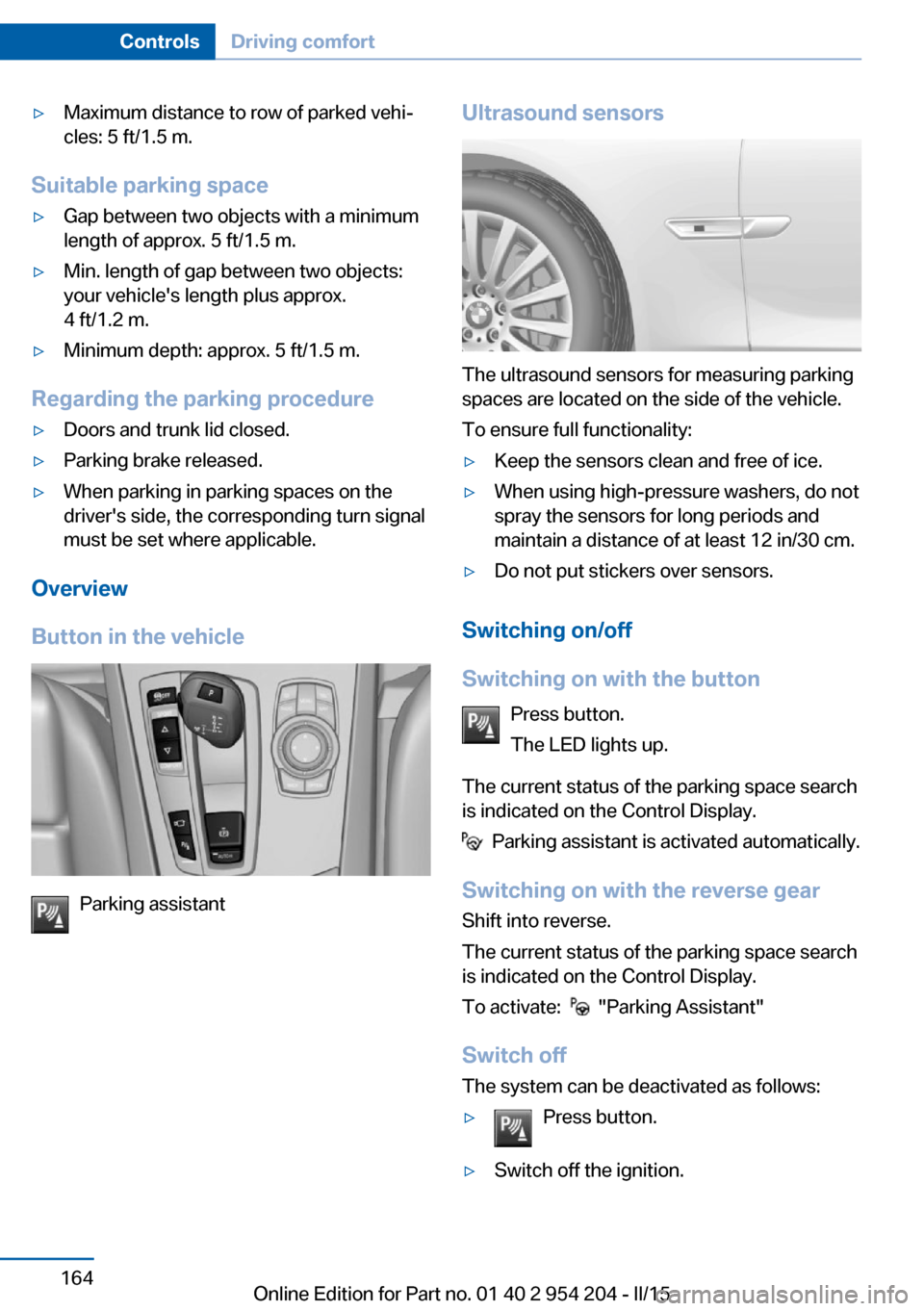
▷Maximum distance to row of parked vehi‐
cles: 5 ft/1.5 m.
Suitable parking space
▷Gap between two objects with a minimum
length of approx. 5 ft/1.5 m.▷Min. length of gap between two objects:
your vehicle's length plus approx.
4 ft/1.2 m.▷Minimum depth: approx. 5 ft/1.5 m.
Regarding the parking procedure
▷Doors and trunk lid closed.▷Parking brake released.▷When parking in parking spaces on the
driver's side, the corresponding turn signal
must be set where applicable.
Overview
Button in the vehicle
Parking assistant
Ultrasound sensors
The ultrasound sensors for measuring parking
spaces are located on the side of the vehicle.
To ensure full functionality:
▷Keep the sensors clean and free of ice.▷When using high-pressure washers, do not
spray the sensors for long periods and
maintain a distance of at least 12 in/30 cm.▷Do not put stickers over sensors.
Switching on/off
Switching on with the button Press button.
The LED lights up.
The current status of the parking space search
is indicated on the Control Display.
Parking assistant is activated automatically.
Switching on with the reverse gear
Shift into reverse.
The current status of the parking space search
is indicated on the Control Display.
To activate:
"Parking Assistant"
Switch off
The system can be deactivated as follows:
▷Press button.▷Switch off the ignition.Seite 164ControlsDriving comfort164
Online Edition for Part no. 01 40 2 954 204 - II/15
Page 170 of 262
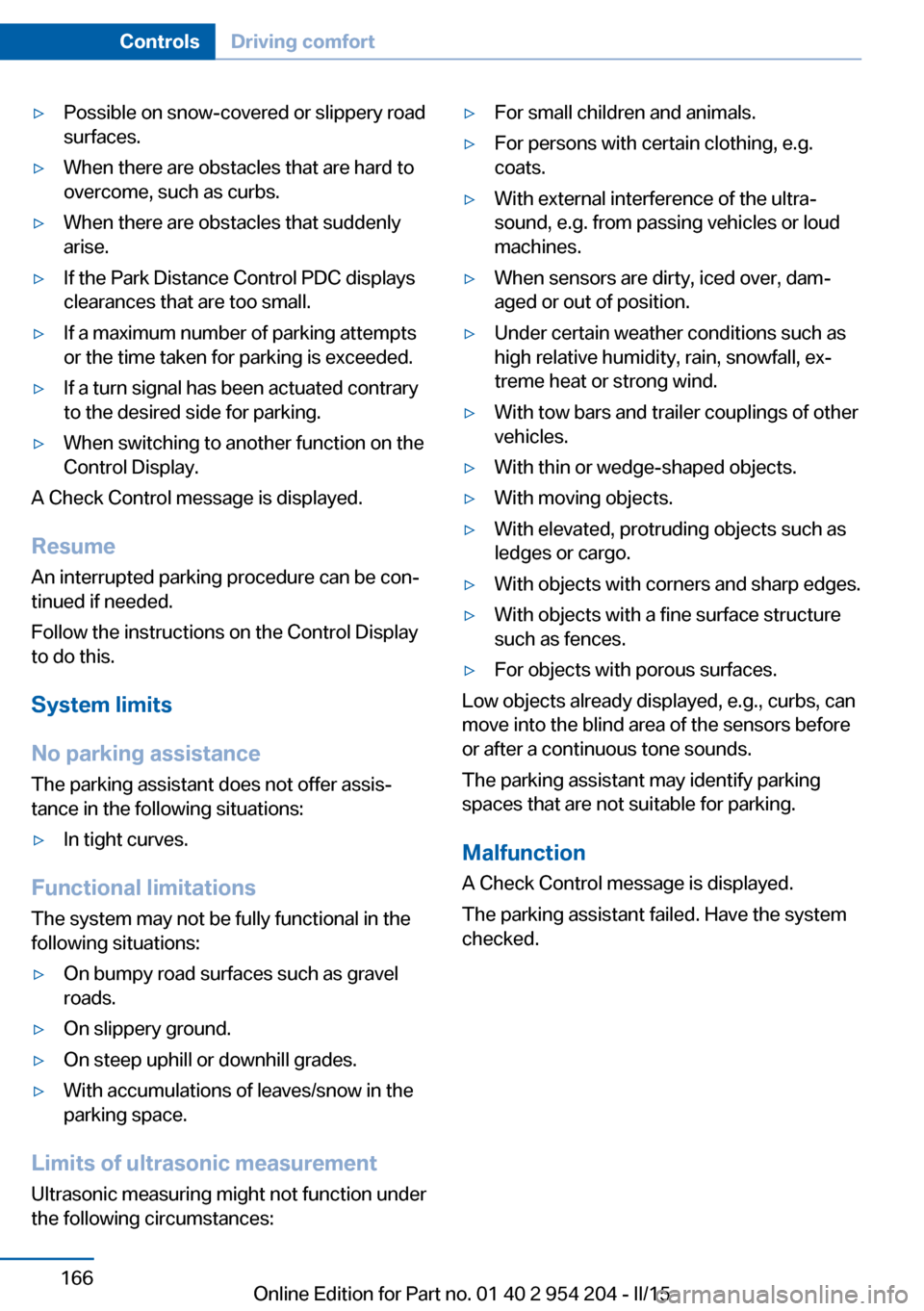
▷Possible on snow-covered or slippery road
surfaces.▷When there are obstacles that are hard to
overcome, such as curbs.▷When there are obstacles that suddenly
arise.▷If the Park Distance Control PDC displays
clearances that are too small.▷If a maximum number of parking attempts
or the time taken for parking is exceeded.▷If a turn signal has been actuated contrary
to the desired side for parking.▷When switching to another function on the
Control Display.
A Check Control message is displayed.
Resume An interrupted parking procedure can be con‐
tinued if needed.
Follow the instructions on the Control Display
to do this.
System limits
No parking assistance
The parking assistant does not offer assis‐
tance in the following situations:
▷In tight curves.
Functional limitations
The system may not be fully functional in the
following situations:
▷On bumpy road surfaces such as gravel
roads.▷On slippery ground.▷On steep uphill or downhill grades.▷With accumulations of leaves/snow in the
parking space.
Limits of ultrasonic measurement
Ultrasonic measuring might not function under
the following circumstances:
▷For small children and animals.▷For persons with certain clothing, e.g.
coats.▷With external interference of the ultra‐
sound, e.g. from passing vehicles or loud
machines.▷When sensors are dirty, iced over, dam‐
aged or out of position.▷Under certain weather conditions such as
high relative humidity, rain, snowfall, ex‐
treme heat or strong wind.▷With tow bars and trailer couplings of other
vehicles.▷With thin or wedge-shaped objects.▷With moving objects.▷With elevated, protruding objects such as
ledges or cargo.▷With objects with corners and sharp edges.▷With objects with a fine surface structure
such as fences.▷For objects with porous surfaces.
Low objects already displayed, e.g., curbs, can
move into the blind area of the sensors before
or after a continuous tone sounds.
The parking assistant may identify parking
spaces that are not suitable for parking.
Malfunction
A Check Control message is displayed.
The parking assistant failed. Have the system
checked.
Seite 166ControlsDriving comfort166
Online Edition for Part no. 01 40 2 954 204 - II/15
Page 172 of 262
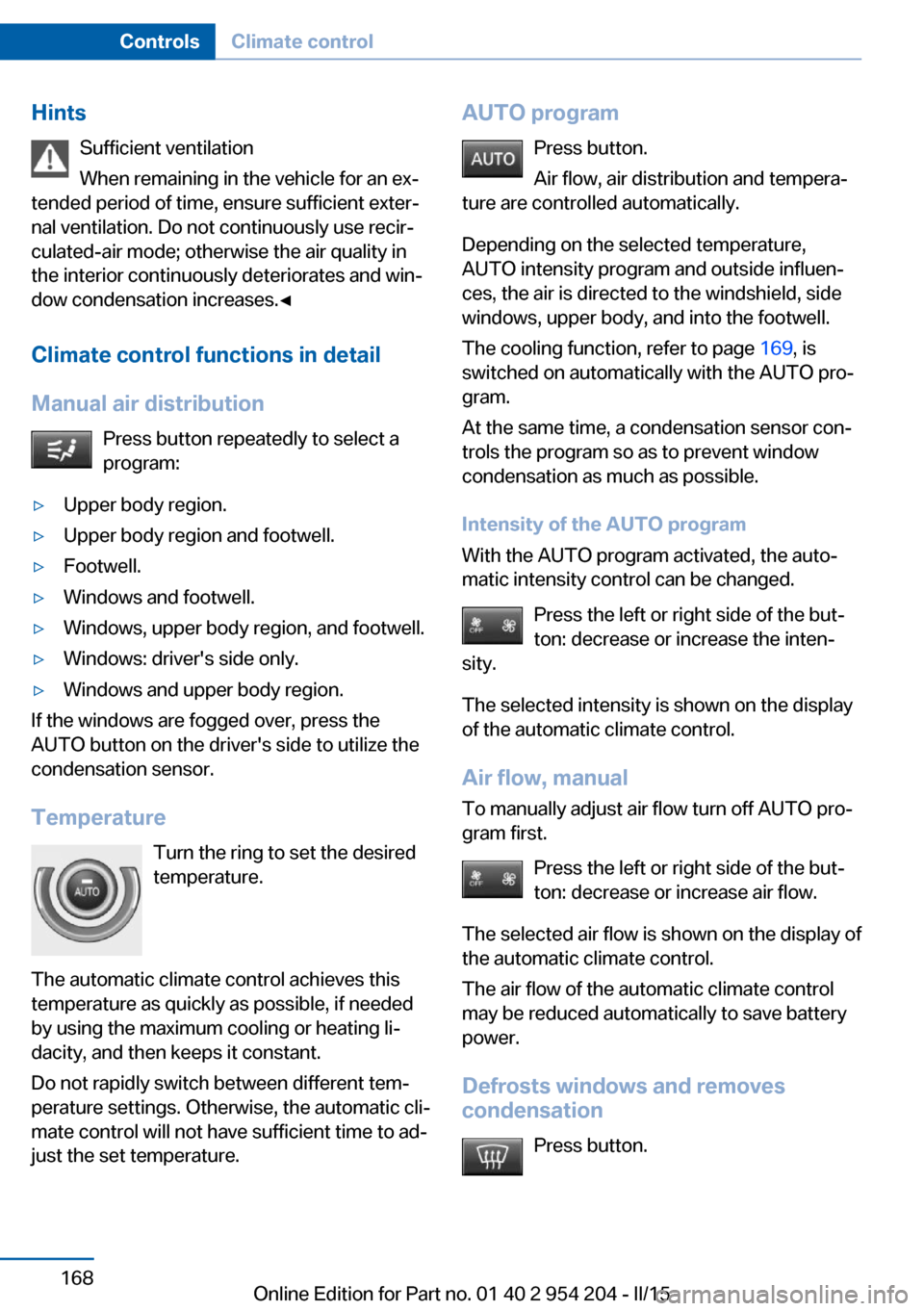
HintsSufficient ventilation
When remaining in the vehicle for an ex‐
tended period of time, ensure sufficient exter‐
nal ventilation. Do not continuously use recir‐
culated-air mode; otherwise the air quality in
the interior continuously deteriorates and win‐
dow condensation increases.◀
Climate control functions in detail
Manual air distribution Press button repeatedly to select a
program:▷Upper body region.▷Upper body region and footwell.▷Footwell.▷Windows and footwell.▷Windows, upper body region, and footwell.▷Windows: driver's side only.▷Windows and upper body region.
If the windows are fogged over, press the
AUTO button on the driver's side to utilize the
condensation sensor.
Temperature Turn the ring to set the desired
temperature.
The automatic climate control achieves this
temperature as quickly as possible, if needed
by using the maximum cooling or heating li‐
dacity, and then keeps it constant.
Do not rapidly switch between different tem‐
perature settings. Otherwise, the automatic cli‐
mate control will not have sufficient time to ad‐
just the set temperature.
AUTO program
Press button.
Air flow, air distribution and tempera‐
ture are controlled automatically.
Depending on the selected temperature,
AUTO intensity program and outside influen‐
ces, the air is directed to the windshield, side
windows, upper body, and into the footwell.
The cooling function, refer to page 169, is
switched on automatically with the AUTO pro‐
gram.
At the same time, a condensation sensor con‐
trols the program so as to prevent window
condensation as much as possible.
Intensity of the AUTO program
With the AUTO program activated, the auto‐
matic intensity control can be changed.
Press the left or right side of the but‐
ton: decrease or increase the inten‐
sity.
The selected intensity is shown on the display
of the automatic climate control.
Air flow, manual
To manually adjust air flow turn off AUTO pro‐
gram first.
Press the left or right side of the but‐
ton: decrease or increase air flow.
The selected air flow is shown on the display of
the automatic climate control.
The air flow of the automatic climate control
may be reduced automatically to save battery
power.
Defrosts windows and removes
condensation
Press button.Seite 168ControlsClimate control168
Online Edition for Part no. 01 40 2 954 204 - II/15
Page 173 of 262
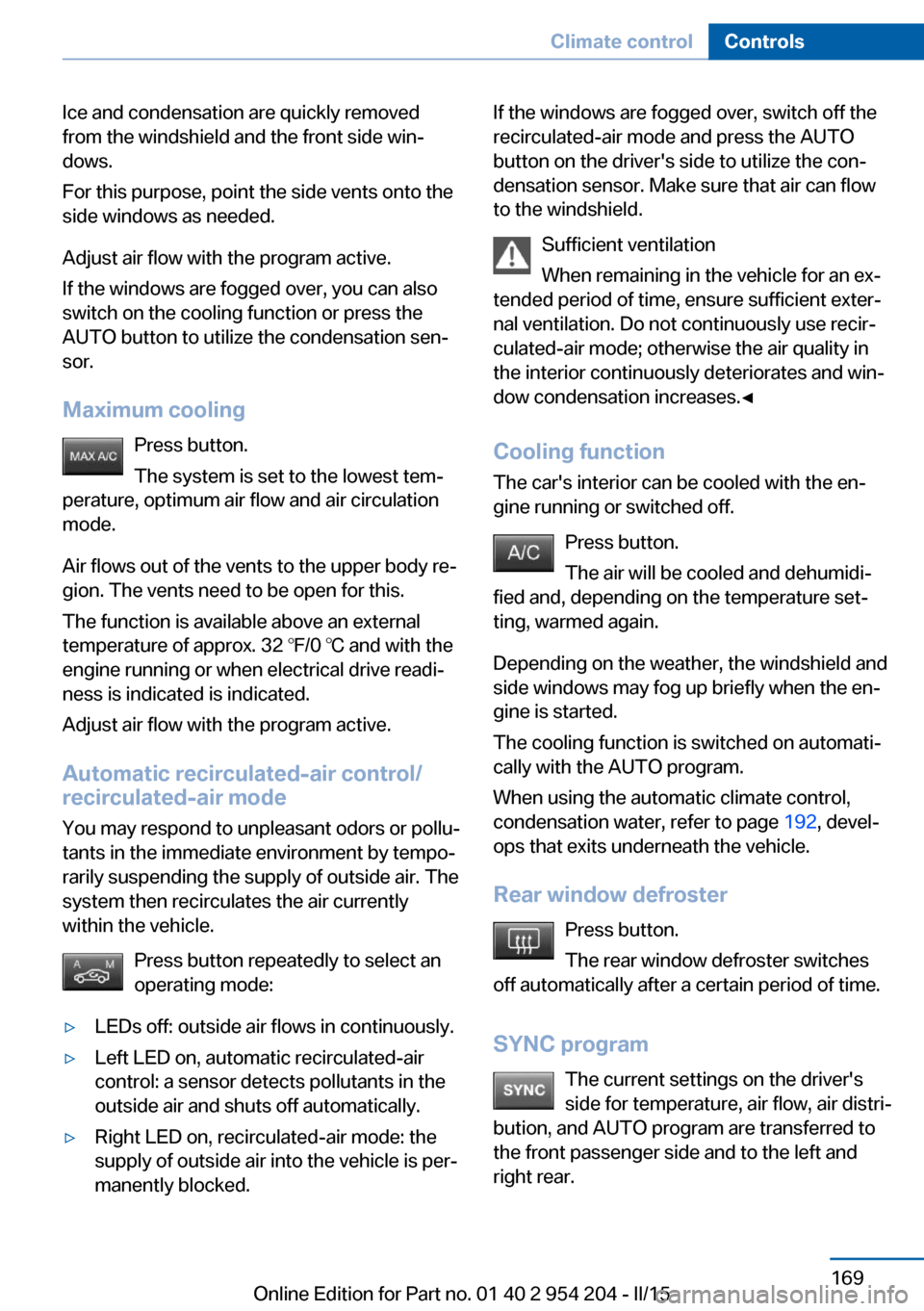
Ice and condensation are quickly removed
from the windshield and the front side win‐
dows.
For this purpose, point the side vents onto the
side windows as needed.
Adjust air flow with the program active.
If the windows are fogged over, you can also
switch on the cooling function or press the
AUTO button to utilize the condensation sen‐
sor.
Maximum cooling Press button.
The system is set to the lowest tem‐
perature, optimum air flow and air circulation mode.
Air flows out of the vents to the upper body re‐
gion. The vents need to be open for this.
The function is available above an external
temperature of approx. 32 ℉/0 ℃ and with the
engine running or when electrical drive readi‐ ness is indicated is indicated.
Adjust air flow with the program active.
Automatic recirculated-air control/
recirculated-air mode
You may respond to unpleasant odors or pollu‐
tants in the immediate environment by tempo‐
rarily suspending the supply of outside air. The
system then recirculates the air currently
within the vehicle.
Press button repeatedly to select an
operating mode:▷LEDs off: outside air flows in continuously.▷Left LED on, automatic recirculated-air
control: a sensor detects pollutants in the
outside air and shuts off automatically.▷Right LED on, recirculated-air mode: the
supply of outside air into the vehicle is per‐
manently blocked.If the windows are fogged over, switch off the
recirculated-air mode and press the AUTO
button on the driver's side to utilize the con‐
densation sensor. Make sure that air can flow
to the windshield.
Sufficient ventilation
When remaining in the vehicle for an ex‐
tended period of time, ensure sufficient exter‐
nal ventilation. Do not continuously use recir‐
culated-air mode; otherwise the air quality in
the interior continuously deteriorates and win‐
dow condensation increases.◀
Cooling function The car's interior can be cooled with the en‐
gine running or switched off.
Press button.
The air will be cooled and dehumidi‐
fied and, depending on the temperature set‐
ting, warmed again.
Depending on the weather, the windshield and
side windows may fog up briefly when the en‐
gine is started.
The cooling function is switched on automati‐
cally with the AUTO program.
When using the automatic climate control,
condensation water, refer to page 192, devel‐
ops that exits underneath the vehicle.
Rear window defroster Press button.
The rear window defroster switches
off automatically after a certain period of time.
SYNC program The current settings on the driver's
side for temperature, air flow, air distri‐
bution, and AUTO program are transferred to the front passenger side and to the left and
right rear.Seite 169Climate controlControls169
Online Edition for Part no. 01 40 2 954 204 - II/15
Page 227 of 262
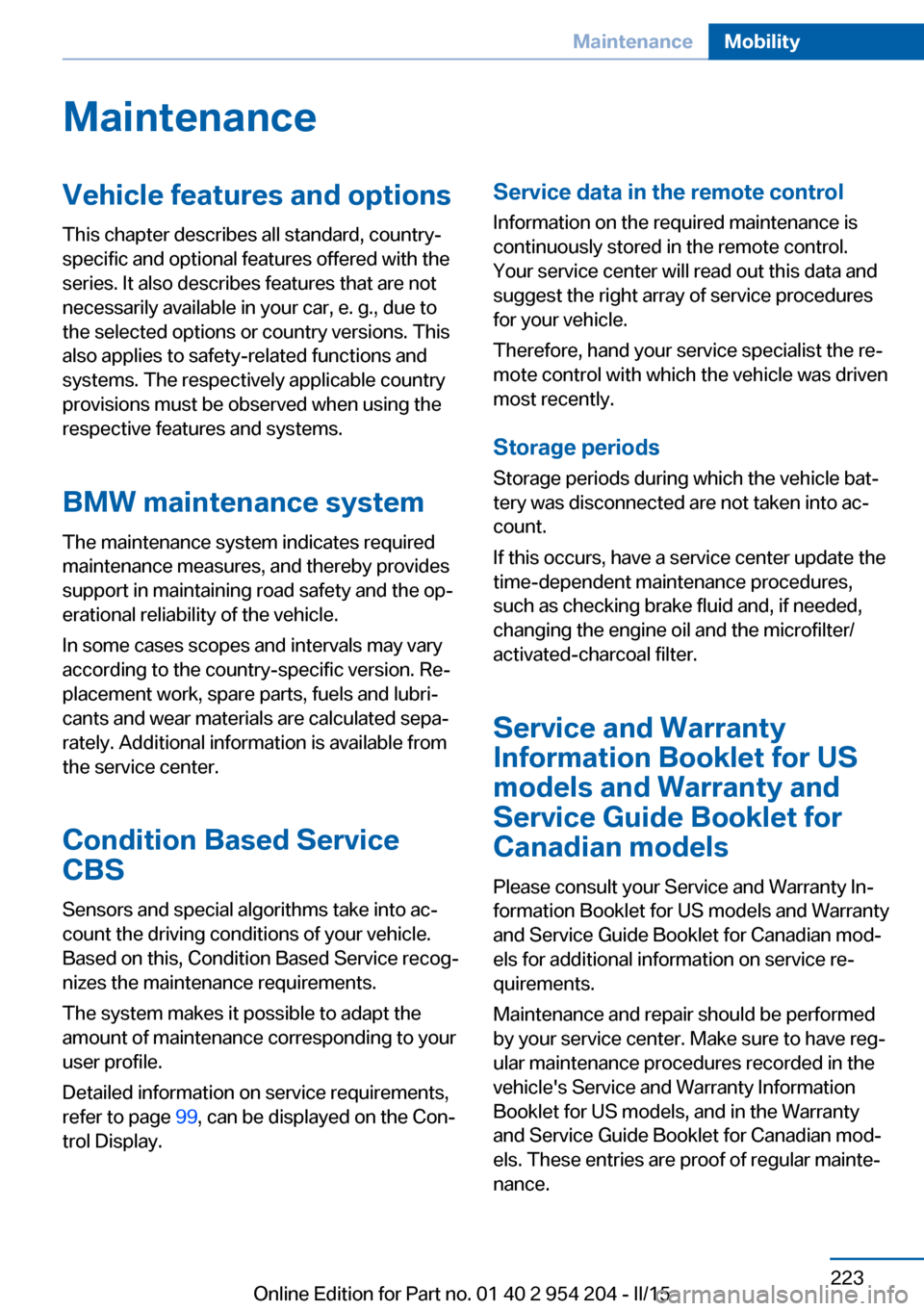
MaintenanceVehicle features and options
This chapter describes all standard, country-
specific and optional features offered with the
series. It also describes features that are not
necessarily available in your car, e. g., due to
the selected options or country versions. This
also applies to safety-related functions and
systems. The respectively applicable country
provisions must be observed when using the
respective features and systems.
BMW maintenance system The maintenance system indicates required
maintenance measures, and thereby provides
support in maintaining road safety and the op‐
erational reliability of the vehicle.
In some cases scopes and intervals may vary
according to the country-specific version. Re‐
placement work, spare parts, fuels and lubri‐
cants and wear materials are calculated sepa‐
rately. Additional information is available from
the service center.
Condition Based Service
CBS
Sensors and special algorithms take into ac‐
count the driving conditions of your vehicle.
Based on this, Condition Based Service recog‐
nizes the maintenance requirements.
The system makes it possible to adapt the
amount of maintenance corresponding to your
user profile.
Detailed information on service requirements,
refer to page 99, can be displayed on the Con‐
trol Display.Service data in the remote control
Information on the required maintenance is
continuously stored in the remote control. Your service center will read out this data and
suggest the right array of service procedures for your vehicle.
Therefore, hand your service specialist the re‐
mote control with which the vehicle was driven
most recently.
Storage periods Storage periods during which the vehicle bat‐
tery was disconnected are not taken into ac‐
count.
If this occurs, have a service center update the
time-dependent maintenance procedures,
such as checking brake fluid and, if needed,
changing the engine oil and the microfilter/
activated-charcoal filter.
Service and Warranty
Information Booklet for US
models and Warranty and
Service Guide Booklet for
Canadian models
Please consult your Service and Warranty In‐
formation Booklet for US models and Warranty
and Service Guide Booklet for Canadian mod‐
els for additional information on service re‐
quirements.
Maintenance and repair should be performed
by your service center. Make sure to have reg‐
ular maintenance procedures recorded in the
vehicle's Service and Warranty Information
Booklet for US models, and in the Warranty
and Service Guide Booklet for Canadian mod‐
els. These entries are proof of regular mainte‐
nance.Seite 223MaintenanceMobility223
Online Edition for Part no. 01 40 2 954 204 - II/15
Page 241 of 262
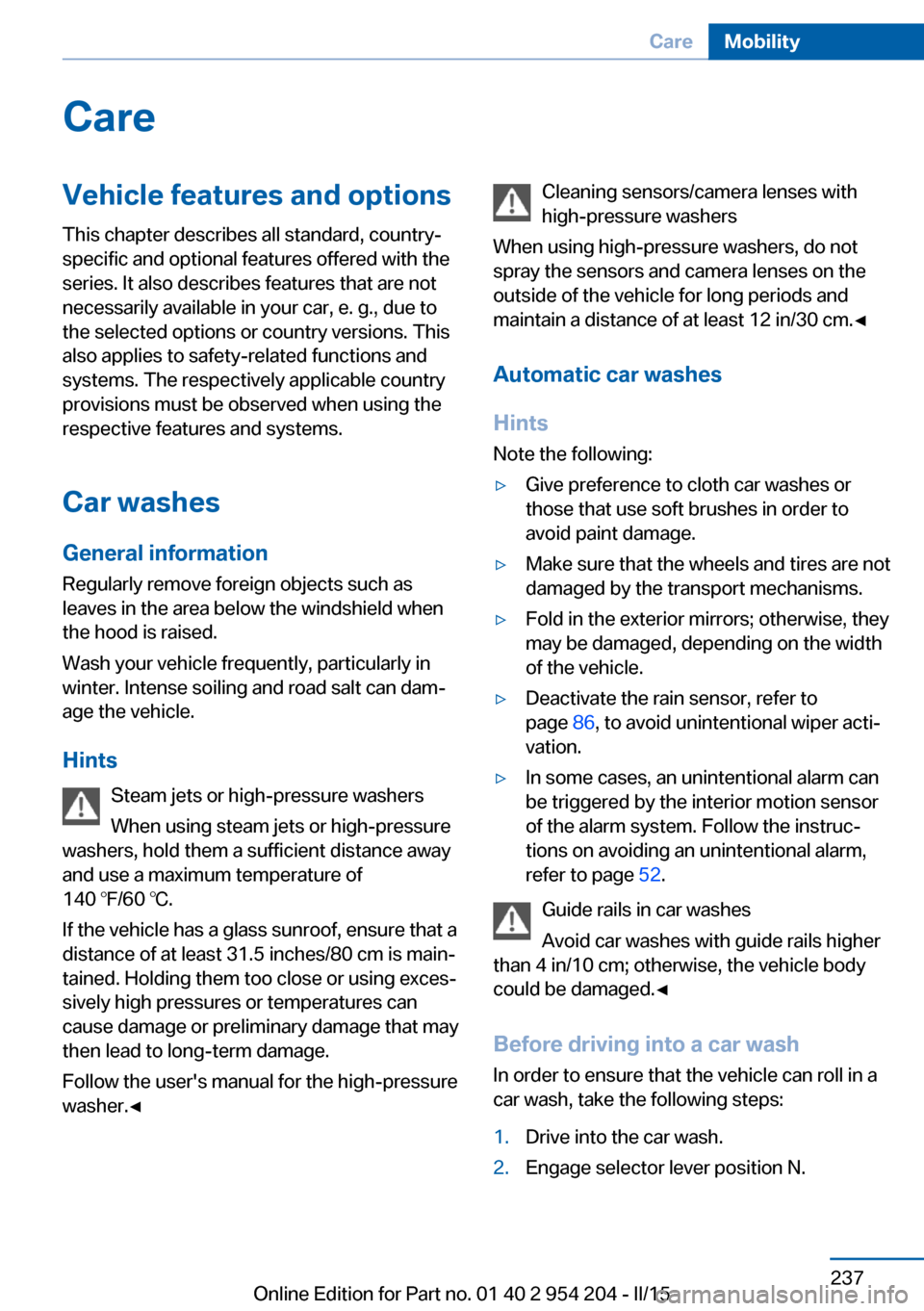
CareVehicle features and optionsThis chapter describes all standard, country-
specific and optional features offered with the
series. It also describes features that are not
necessarily available in your car, e. g., due to
the selected options or country versions. This
also applies to safety-related functions and
systems. The respectively applicable country
provisions must be observed when using the
respective features and systems.
Car washes General information
Regularly remove foreign objects such as
leaves in the area below the windshield when
the hood is raised.
Wash your vehicle frequently, particularly in
winter. Intense soiling and road salt can dam‐
age the vehicle.
Hints Steam jets or high-pressure washers
When using steam jets or high-pressure
washers, hold them a sufficient distance away
and use a maximum temperature of
140 ℉/60 ℃.
If the vehicle has a glass sunroof, ensure that a
distance of at least 31.5 inches/80 cm is main‐
tained. Holding them too close or using exces‐
sively high pressures or temperatures can
cause damage or preliminary damage that may
then lead to long-term damage.
Follow the user's manual for the high-pressure
washer.◀Cleaning sensors/camera lenses with
high-pressure washers
When using high-pressure washers, do not
spray the sensors and camera lenses on the
outside of the vehicle for long periods and
maintain a distance of at least 12 in/30 cm.◀
Automatic car washes
Hints
Note the following:▷Give preference to cloth car washes or
those that use soft brushes in order to
avoid paint damage.▷Make sure that the wheels and tires are not
damaged by the transport mechanisms.▷Fold in the exterior mirrors; otherwise, they
may be damaged, depending on the width
of the vehicle.▷Deactivate the rain sensor, refer to
page 86, to avoid unintentional wiper acti‐
vation.▷In some cases, an unintentional alarm can
be triggered by the interior motion sensor
of the alarm system. Follow the instruc‐
tions on avoiding an unintentional alarm,
refer to page 52.
Guide rails in car washes
Avoid car washes with guide rails higher
than 4 in/10 cm; otherwise, the vehicle body
could be damaged.◀
Before driving into a car wash In order to ensure that the vehicle can roll in a
car wash, take the following steps:
1.Drive into the car wash.2.Engage selector lever position N.Seite 237CareMobility237
Online Edition for Part no. 01 40 2 954 204 - II/15
Page 244 of 262
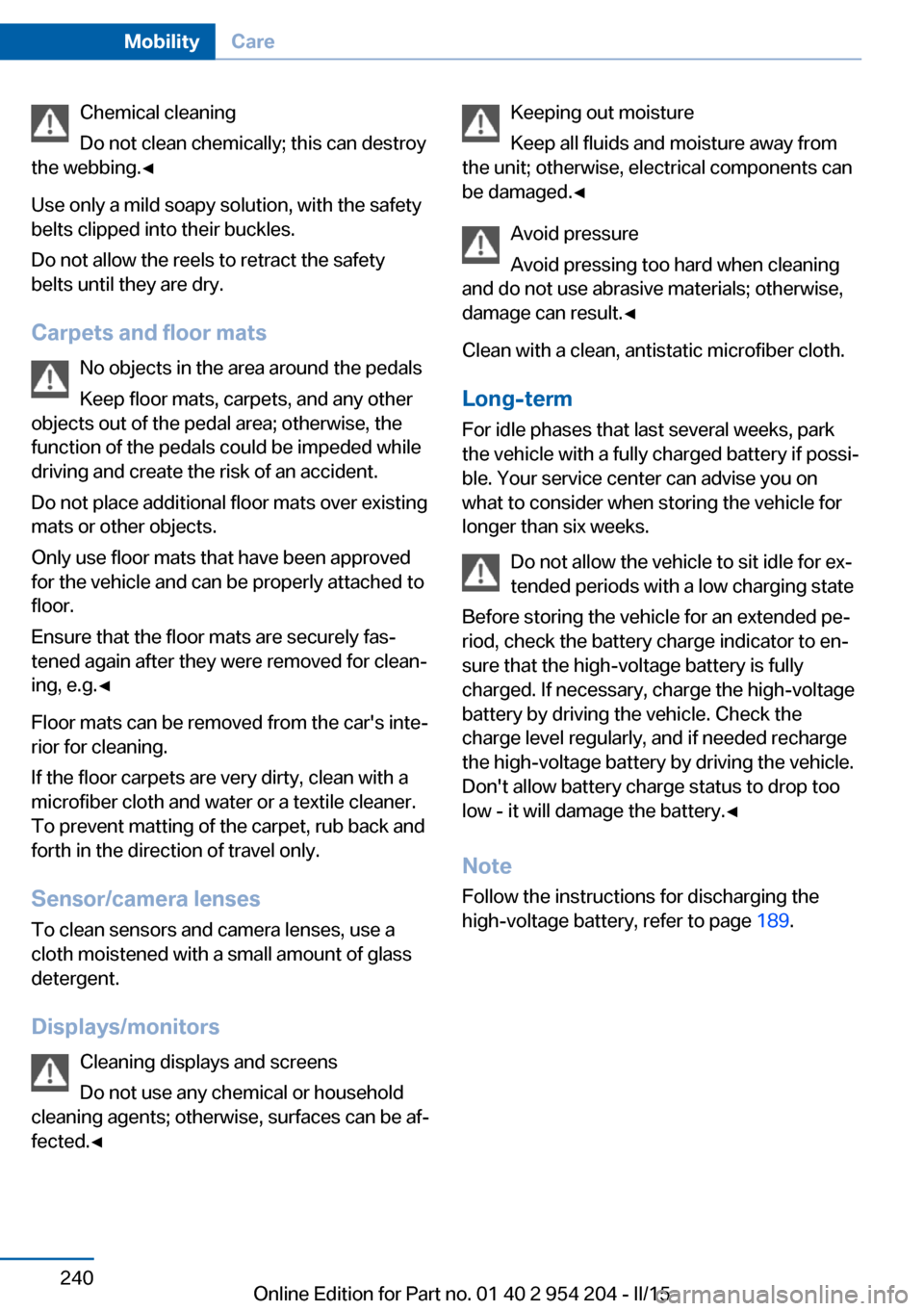
Chemical cleaning
Do not clean chemically; this can destroy
the webbing.◀
Use only a mild soapy solution, with the safety
belts clipped into their buckles.
Do not allow the reels to retract the safety
belts until they are dry.
Carpets and floor mats No objects in the area around the pedals
Keep floor mats, carpets, and any other
objects out of the pedal area; otherwise, the
function of the pedals could be impeded while
driving and create the risk of an accident.
Do not place additional floor mats over existing
mats or other objects.
Only use floor mats that have been approved
for the vehicle and can be properly attached to
floor.
Ensure that the floor mats are securely fas‐
tened again after they were removed for clean‐
ing, e.g.◀
Floor mats can be removed from the car's inte‐
rior for cleaning.
If the floor carpets are very dirty, clean with a
microfiber cloth and water or a textile cleaner.
To prevent matting of the carpet, rub back and
forth in the direction of travel only.
Sensor/camera lenses
To clean sensors and camera lenses, use a
cloth moistened with a small amount of glass
detergent.
Displays/monitors Cleaning displays and screens
Do not use any chemical or household
cleaning agents; otherwise, surfaces can be af‐
fected.◀Keeping out moisture
Keep all fluids and moisture away from
the unit; otherwise, electrical components can
be damaged.◀
Avoid pressure
Avoid pressing too hard when cleaning
and do not use abrasive materials; otherwise,
damage can result.◀
Clean with a clean, antistatic microfiber cloth.
Long-term
For idle phases that last several weeks, park
the vehicle with a fully charged battery if possi‐
ble. Your service center can advise you on
what to consider when storing the vehicle for
longer than six weeks.
Do not allow the vehicle to sit idle for ex‐
tended periods with a low charging state
Before storing the vehicle for an extended pe‐
riod, check the battery charge indicator to en‐
sure that the high-voltage battery is fully
charged. If necessary, charge the high-voltage
battery by driving the vehicle. Check the
charge level regularly, and if needed recharge
the high-voltage battery by driving the vehicle.
Don't allow battery charge status to drop too
low - it will damage the battery.◀
NoteFollow the instructions for discharging thehigh-voltage battery, refer to page 189.Seite 240MobilityCare240
Online Edition for Part no. 01 40 2 954 204 - II/15
Page 254 of 262
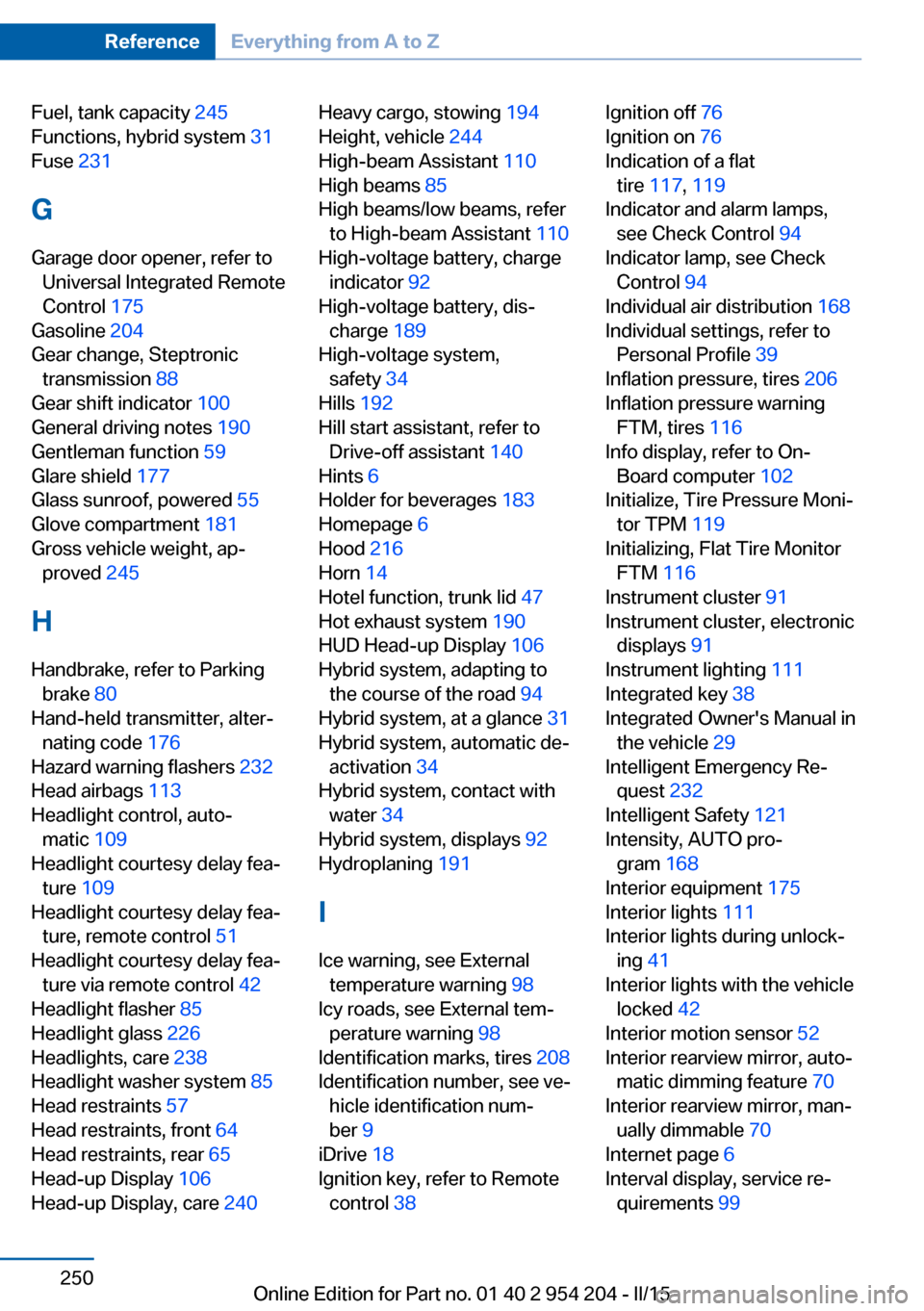
Fuel, tank capacity 245
Functions, hybrid system 31
Fuse 231
G
Garage door opener, refer to Universal Integrated Remote
Control 175
Gasoline 204
Gear change, Steptronic transmission 88
Gear shift indicator 100
General driving notes 190
Gentleman function 59
Glare shield 177
Glass sunroof, powered 55
Glove compartment 181
Gross vehicle weight, ap‐ proved 245
H
Handbrake, refer to Parking brake 80
Hand-held transmitter, alter‐ nating code 176
Hazard warning flashers 232
Head airbags 113
Headlight control, auto‐ matic 109
Headlight courtesy delay fea‐ ture 109
Headlight courtesy delay fea‐ ture, remote control 51
Headlight courtesy delay fea‐ ture via remote control 42
Headlight flasher 85
Headlight glass 226
Headlights, care 238
Headlight washer system 85
Head restraints 57
Head restraints, front 64
Head restraints, rear 65
Head-up Display 106
Head-up Display, care 240 Heavy cargo, stowing 194
Height, vehicle 244
High-beam Assistant 110
High beams 85
High beams/low beams, refer to High-beam Assistant 110
High-voltage battery, charge indicator 92
High-voltage battery, dis‐ charge 189
High-voltage system, safety 34
Hills 192
Hill start assistant, refer to Drive-off assistant 140
Hints 6
Holder for beverages 183
Homepage 6
Hood 216
Horn 14
Hotel function, trunk lid 47
Hot exhaust system 190
HUD Head-up Display 106
Hybrid system, adapting to the course of the road 94
Hybrid system, at a glance 31
Hybrid system, automatic de‐ activation 34
Hybrid system, contact with water 34
Hybrid system, displays 92
Hydroplaning 191
I Ice warning, see External temperature warning 98
Icy roads, see External tem‐ perature warning 98
Identification marks, tires 208
Identification number, see ve‐ hicle identification num‐
ber 9
iDrive 18
Ignition key, refer to Remote control 38 Ignition off 76
Ignition on 76
Indication of a flat tire 117 , 119
Indicator and alarm lamps, see Check Control 94
Indicator lamp, see Check Control 94
Individual air distribution 168
Individual settings, refer to Personal Profile 39
Inflation pressure, tires 206
Inflation pressure warning FTM, tires 116
Info display, refer to On- Board computer 102
Initialize, Tire Pressure Moni‐ tor TPM 119
Initializing, Flat Tire Monitor FTM 116
Instrument cluster 91
Instrument cluster, electronic displays 91
Instrument lighting 111
Integrated key 38
Integrated Owner's Manual in the vehicle 29
Intelligent Emergency Re‐ quest 232
Intelligent Safety 121
Intensity, AUTO pro‐ gram 168
Interior equipment 175
Interior lights 111
Interior lights during unlock‐ ing 41
Interior lights with the vehicle locked 42
Interior motion sensor 52
Interior rearview mirror, auto‐ matic dimming feature 70
Interior rearview mirror, man‐ ually dimmable 70
Internet page 6
Interval display, service re‐ quirements 99 Seite 250ReferenceEverything from A to Z250
Online Edition for Part no. 01 40 2 954 204 - II/15
Page 257 of 262
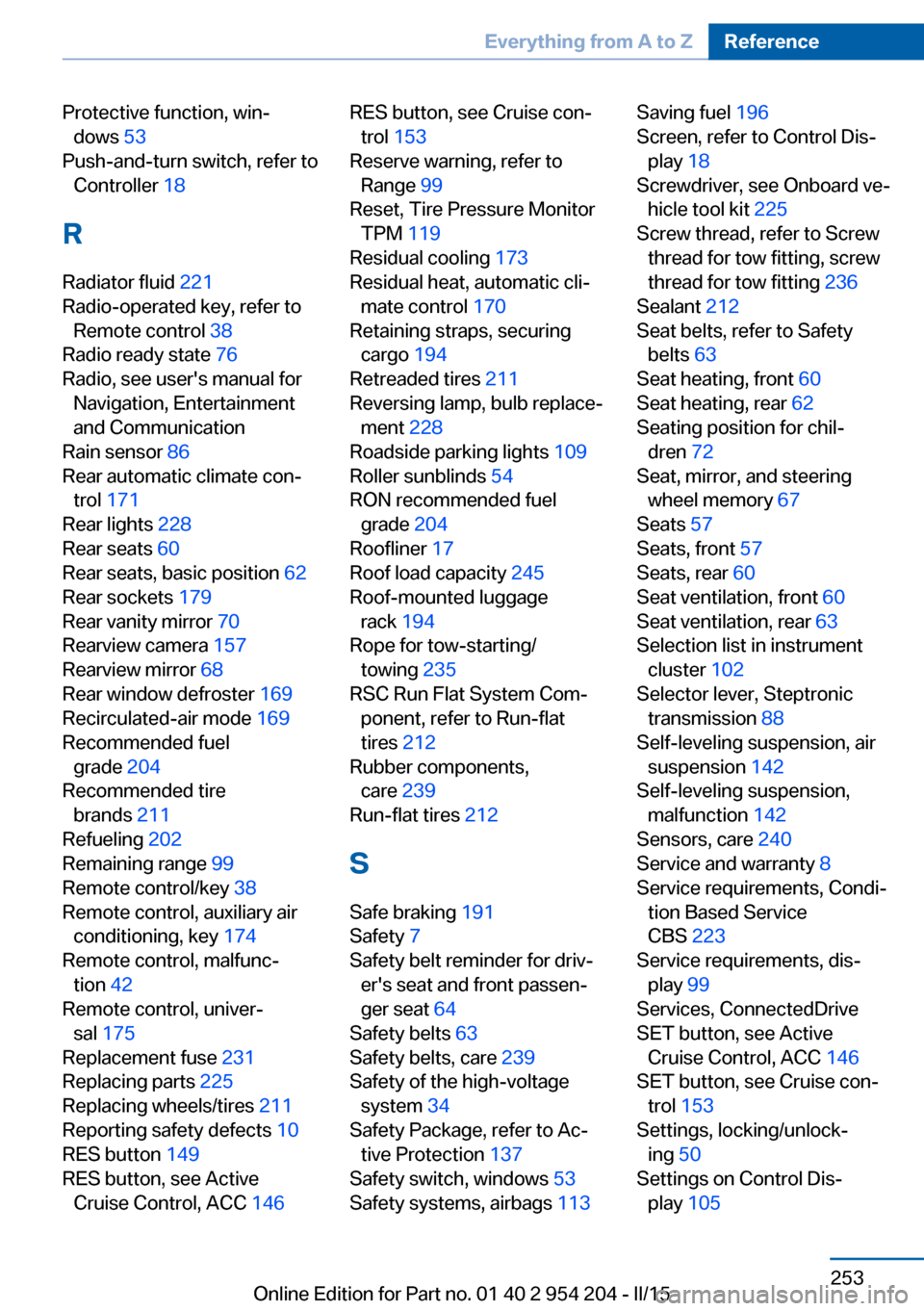
Protective function, win‐dows 53
Push-and-turn switch, refer to Controller 18
R Radiator fluid 221
Radio-operated key, refer to Remote control 38
Radio ready state 76
Radio, see user's manual for Navigation, Entertainment
and Communication
Rain sensor 86
Rear automatic climate con‐ trol 171
Rear lights 228
Rear seats 60
Rear seats, basic position 62
Rear sockets 179
Rear vanity mirror 70
Rearview camera 157
Rearview mirror 68
Rear window defroster 169
Recirculated-air mode 169
Recommended fuel grade 204
Recommended tire brands 211
Refueling 202
Remaining range 99
Remote control/key 38
Remote control, auxiliary air conditioning, key 174
Remote control, malfunc‐ tion 42
Remote control, univer‐ sal 175
Replacement fuse 231
Replacing parts 225
Replacing wheels/tires 211
Reporting safety defects 10
RES button 149
RES button, see Active Cruise Control, ACC 146 RES button, see Cruise con‐
trol 153
Reserve warning, refer to Range 99
Reset, Tire Pressure Monitor TPM 119
Residual cooling 173
Residual heat, automatic cli‐ mate control 170
Retaining straps, securing cargo 194
Retreaded tires 211
Reversing lamp, bulb replace‐ ment 228
Roadside parking lights 109
Roller sunblinds 54
RON recommended fuel grade 204
Roofliner 17
Roof load capacity 245
Roof-mounted luggage rack 194
Rope for tow-starting/ towing 235
RSC Run Flat System Com‐ ponent, refer to Run-flat
tires 212
Rubber components, care 239
Run-flat tires 212
S Safe braking 191
Safety 7
Safety belt reminder for driv‐ er's seat and front passen‐
ger seat 64
Safety belts 63
Safety belts, care 239
Safety of the high-voltage system 34
Safety Package, refer to Ac‐ tive Protection 137
Safety switch, windows 53
Safety systems, airbags 113 Saving fuel 196
Screen, refer to Control Dis‐ play 18
Screwdriver, see Onboard ve‐ hicle tool kit 225
Screw thread, refer to Screw thread for tow fitting, screw
thread for tow fitting 236
Sealant 212
Seat belts, refer to Safety belts 63
Seat heating, front 60
Seat heating, rear 62
Seating position for chil‐ dren 72
Seat, mirror, and steering wheel memory 67
Seats 57
Seats, front 57
Seats, rear 60
Seat ventilation, front 60
Seat ventilation, rear 63
Selection list in instrument cluster 102
Selector lever, Steptronic transmission 88
Self-leveling suspension, air suspension 142
Self-leveling suspension, malfunction 142
Sensors, care 240
Service and warranty 8
Service requirements, Condi‐ tion Based Service
CBS 223
Service requirements, dis‐ play 99
Services, ConnectedDrive
SET button, see Active Cruise Control, ACC 146
SET button, see Cruise con‐ trol 153
Settings, locking/unlock‐ ing 50
Settings on Control Dis‐ play 105 Seite 253Everything from A to ZReference253
Online Edition for Part no. 01 40 2 954 204 - II/15
Page 258 of 262
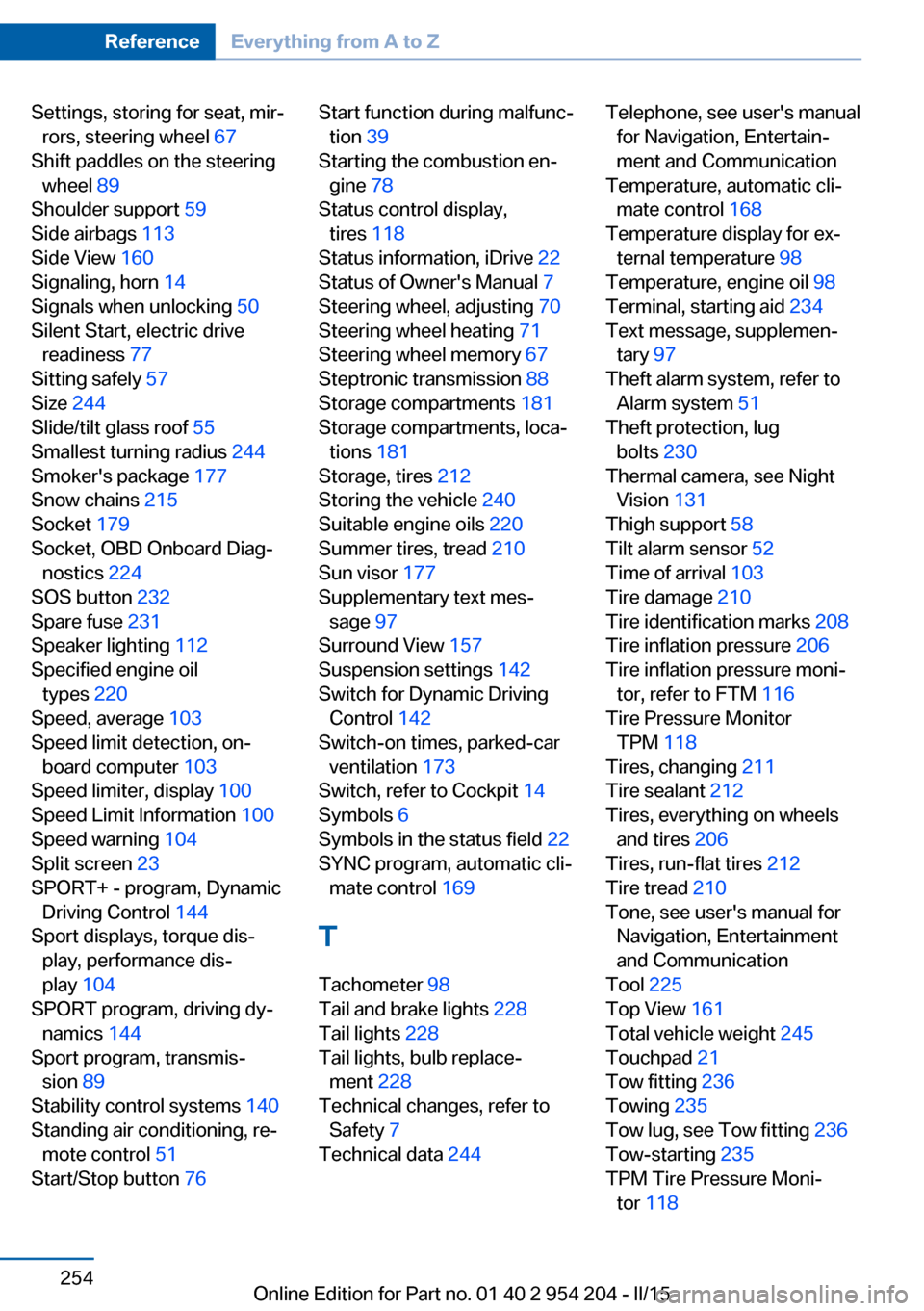
Settings, storing for seat, mir‐rors, steering wheel 67
Shift paddles on the steering wheel 89
Shoulder support 59
Side airbags 113
Side View 160
Signaling, horn 14
Signals when unlocking 50
Silent Start, electric drive readiness 77
Sitting safely 57
Size 244
Slide/tilt glass roof 55
Smallest turning radius 244
Smoker's package 177
Snow chains 215
Socket 179
Socket, OBD Onboard Diag‐ nostics 224
SOS button 232
Spare fuse 231
Speaker lighting 112
Specified engine oil types 220
Speed, average 103
Speed limit detection, on- board computer 103
Speed limiter, display 100
Speed Limit Information 100
Speed warning 104
Split screen 23
SPORT+ - program, Dynamic Driving Control 144
Sport displays, torque dis‐ play, performance dis‐
play 104
SPORT program, driving dy‐ namics 144
Sport program, transmis‐ sion 89
Stability control systems 140
Standing air conditioning, re‐ mote control 51
Start/Stop button 76 Start function during malfunc‐
tion 39
Starting the combustion en‐ gine 78
Status control display, tires 118
Status information, iDrive 22
Status of Owner's Manual 7
Steering wheel, adjusting 70
Steering wheel heating 71
Steering wheel memory 67
Steptronic transmission 88
Storage compartments 181
Storage compartments, loca‐ tions 181
Storage, tires 212
Storing the vehicle 240
Suitable engine oils 220
Summer tires, tread 210
Sun visor 177
Supplementary text mes‐ sage 97
Surround View 157
Suspension settings 142
Switch for Dynamic Driving Control 142
Switch-on times, parked-car ventilation 173
Switch, refer to Cockpit 14
Symbols 6
Symbols in the status field 22
SYNC program, automatic cli‐ mate control 169
T Tachometer 98
Tail and brake lights 228
Tail lights 228
Tail lights, bulb replace‐ ment 228
Technical changes, refer to Safety 7
Technical data 244 Telephone, see user's manual
for Navigation, Entertain‐
ment and Communication
Temperature, automatic cli‐ mate control 168
Temperature display for ex‐ ternal temperature 98
Temperature, engine oil 98
Terminal, starting aid 234
Text message, supplemen‐ tary 97
Theft alarm system, refer to Alarm system 51
Theft protection, lug bolts 230
Thermal camera, see Night Vision 131
Thigh support 58
Tilt alarm sensor 52
Time of arrival 103
Tire damage 210
Tire identification marks 208
Tire inflation pressure 206
Tire inflation pressure moni‐ tor, refer to FTM 116
Tire Pressure Monitor TPM 118
Tires, changing 211
Tire sealant 212
Tires, everything on wheels and tires 206
Tires, run-flat tires 212
Tire tread 210
Tone, see user's manual for Navigation, Entertainment
and Communication
Tool 225
Top View 161
Total vehicle weight 245
Touchpad 21
Tow fitting 236
Towing 235
Tow lug, see Tow fitting 236
Tow-starting 235
TPM Tire Pressure Moni‐ tor 118 Seite 254ReferenceEverything from A to Z254
Online Edition for Part no. 01 40 2 954 204 - II/15